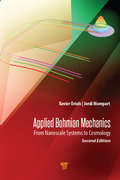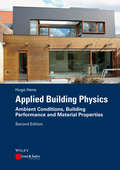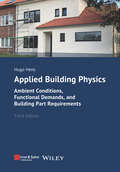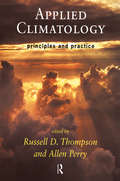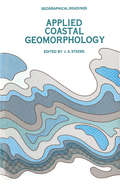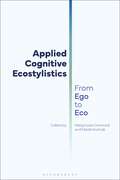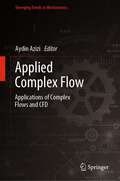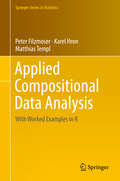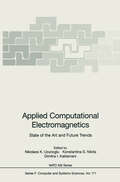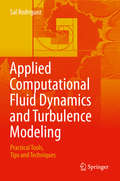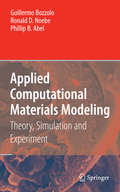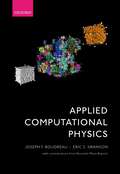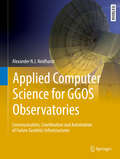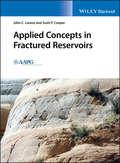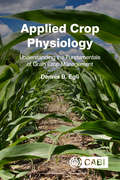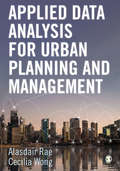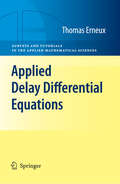- Table View
- List View
Applied Bohmian Mechanics: From Nanoscale Systems to Cosmology
by Xavier Oriols Pladevall Jordi MompartMost textbooks explain quantum mechanics as a story where each step follows naturally from the one preceding it. However, the development of quantum mechanics was exactly the opposite. It was a zigzag route, full of personal disputes where scientists were forced to abandon well-established classical concepts and to explore new and imaginative pathways. Some of the explored routes were successful in providing new mathematical formalisms capable of predicting experiments at the atomic scale. However, even such successful routes were painful enough, so that relevant scientists like Albert Einstein and Erwin Schrödinger decided not to support them. In this book, the authors demonstrate the huge practical utility of another of these routes in explaining quantum phenomena in many different research fields. Bohmian mechanics, the formulation of the quantum theory pioneered by Louis de Broglie and David Bohm, offers an alternative mathematical formulation of quantum phenomena in terms of quantum trajectories. Novel computational tools to explore physical scenarios that are currently computationally inaccessible, such as many-particle solutions of the Schrödinger equation, can be developed from it.
Applied Bohmian Mechanics: From Nanoscale Systems to Cosmology
by Xavier Oriols Pladevall Jordi MompartMost textbooks explain quantum mechanics as a story where each step follows naturally from the one preceding it. However, the development of quantum mechanics was exactly the opposite. It was a zigzag route, full of personal disputes where scientists were forced to abandon well-established classical concepts and to explore new and imaginative pathways. Some of the explored routes were successful in providing new mathematical formalisms capable of predicting experiments at the atomic scale. However, even such successful routes were painful enough, so that relevant scientists like Albert Einstein and Erwin Schrödinger decided not to support them. In this book, the authors demonstrate the huge practical utility of another of these routes in explaining quantum phenomena in many different research fields. Bohmian mechanics, the formulation of the quantum theory pioneered by Louis de Broglie and David Bohm, offers an alternative mathematical formulation of quantum phenomena in terms of quantum trajectories. Novel computational tools to explore physical scenarios that are currently computationally inaccessible, such as many-particle solutions of the Schrödinger equation, can be developed from it.
Applied Building Physics: Ambient Conditions, Building Performance and Material Properties
by Hugo S. HensBad experiences with construction quality, the energy crises of 1973 and 1979,complaints about `sick buildings?, thermal, acoustical, visual and olfactory discomfort, the need for good air quality, the move towards more sustainability ? all these have accelerated the development of a field that, for a long time, was hardly more than an academic exercise: building physics. The discipline embraces domains such as heat and mass transfer, building acoustics, lighting, indoor environmental quality and energy efficiency. In some countries, fire safety is also included. Through the application of physical knowledge and its combination with information coming from other disciplines, the field helps to understand the physical phenomena governing building parts, building envelope, whole building and built environment performance, although for the last the wording `urban physics? is used. Building physics has a real impact on performance-based building design. This volume on `Applied Building Physics? discusses the heat, air and moisture performance metrics that affect building design, construction and retrofitting.
Applied Building Physics: Ambient Conditions, Building Performance and Material Properties
by Hugo S. HensBad experiences with construction quality, the energy crises of 1973 and 1979,complaints about `sick buildings?, thermal, acoustical, visual and olfactory discomfort, the need for good air quality, the move towards more sustainability ? all these have accelerated the development of a field that, for a long time, was hardly more than an academic exercise: building physics. The discipline embraces domains such as heat and mass transfer, building acoustics, lighting, indoor environmental quality and energy efficiency. In some countries, fire safety is also included. Through the application of physical knowledge and its combination with information coming from other disciplines, the field helps to understand the physical phenomena governing building parts, building envelope, whole building and built environment performance, although for the last the wording `urban physics? is used. Building physics has a real impact on performance-based building design. This volume on `Applied Building Physics? discusses the heat, air and moisture performance metrics that affect building design, construction and retrofitting.
Applied Building Physics: Ambient Conditions, Functional Demands, and Building Part Requirements
by Hugo S. HensWhile the first volume on building physics deals with the physical principles of heat, air and moisture behaviour of buildings, building structures and components, this second volume on applied building physics focuses on the question of what the desired performance of buildings consists of. To achieve this, knowledge of the external environmental effects and the internal live loads to which buildings are subjected is a necessary first step. Subsequently, the performance requirements and the physical correspondences are deepened with the determination of their physical parameters, at the levels of buildings, building structures and building components. Compared to the second edition, the discussion of criteria is not limited to thermal comfort, but also includes acoustic, visual and olfactory aspects. Likewise, the indoor air quality is considered in a broader way. Analyses and calculations result in sustainable buildings with a comfortable indoor climate from functional and durable building constructions. Compared to the second edition, the text for the third edition has been reorganised, corrected, revised and expanded where appropriate. A useful appendix for quick reference contains standard values of material properties for a wide range of building materials. The analyses and calculations described in this book result in sustainable buildings made of functional and durable building constructions, with comfortable and healthy indoor climate and air quality. Compared to the second edition the text in this third edition has been reshuffled, corrected, reworked and extended where appropriate.
Applied Building Physics: Ambient Conditions, Functional Demands, and Building Part Requirements
by Hugo S. HensWhile the first volume on building physics deals with the physical principles of heat, air and moisture behaviour of buildings, building structures and components, this second volume on applied building physics focuses on the question of what the desired performance of buildings consists of. To achieve this, knowledge of the external environmental effects and the internal live loads to which buildings are subjected is a necessary first step. Subsequently, the performance requirements and the physical correspondences are deepened with the determination of their physical parameters, at the levels of buildings, building structures and building components. Compared to the second edition, the discussion of criteria is not limited to thermal comfort, but also includes acoustic, visual and olfactory aspects. Likewise, the indoor air quality is considered in a broader way. Analyses and calculations result in sustainable buildings with a comfortable indoor climate from functional and durable building constructions. Compared to the second edition, the text for the third edition has been reorganised, corrected, revised and expanded where appropriate. A useful appendix for quick reference contains standard values of material properties for a wide range of building materials. The analyses and calculations described in this book result in sustainable buildings made of functional and durable building constructions, with comfortable and healthy indoor climate and air quality. Compared to the second edition the text in this third edition has been reshuffled, corrected, reworked and extended where appropriate.
Applied Climatology: Principles and Practice
by Allen Perry Dr Russell Thompson Russell Thompson'Big freeze' conditions, storms, severe flooding, droughts, and heatwaves - recent extremes in weather, with their resultant physical, economic and human losses, highlight the vulnerability of society to changes in the atmosphere. Atmospheric pollution, urbanization, natural atmospheric disasters are causing dramatic changes in climatic environments.Applied Climatology examines the effects of climate on physical, biological and cultural environments. Specialist contributors from Europe, North America and Australasia examine the impacts of changing climates on the functioning and development of physical biological environments including glaciers, water resources, landforms, soils, vegetation and animals.Weather and climate effects day-to-day activities and lifestyles from the clothes we wear to the buildings we design, and the food and energy we produce. This book focusses on the relationship between climate and a wide range of human activities and responses relating to health and comfort, building design, transport systems, agriculture and fisheries, tourism and social, industrial and legal issues.Climate-environment relationships and impacts on human activities are predicted to change dramatically if global warming accelerates at the rates currently proposed. Applied Climatology examines the characteristics and consequences of the changing global climate and considers the future for both natural and human environments.
Applied Climatology: Principles and Practice
by Allen Perry Dr Russell Thompson Russell Thompson'Big freeze' conditions, storms, severe flooding, droughts, and heatwaves - recent extremes in weather, with their resultant physical, economic and human losses, highlight the vulnerability of society to changes in the atmosphere. Atmospheric pollution, urbanization, natural atmospheric disasters are causing dramatic changes in climatic environments.Applied Climatology examines the effects of climate on physical, biological and cultural environments. Specialist contributors from Europe, North America and Australasia examine the impacts of changing climates on the functioning and development of physical biological environments including glaciers, water resources, landforms, soils, vegetation and animals.Weather and climate effects day-to-day activities and lifestyles from the clothes we wear to the buildings we design, and the food and energy we produce. This book focusses on the relationship between climate and a wide range of human activities and responses relating to health and comfort, building design, transport systems, agriculture and fisheries, tourism and social, industrial and legal issues.Climate-environment relationships and impacts on human activities are predicted to change dramatically if global warming accelerates at the rates currently proposed. Applied Climatology examines the characteristics and consequences of the changing global climate and considers the future for both natural and human environments.
Applied Cognitive Ecostylistics: From Ego to Eco
by Malgorzata Drewniok, Marek Kuźniak, andThis book offers an up-to-date account of one of the most influential strands of eco-research: cognitive ecostylistics. The onset of the 1970s saw a global shift in scholarly perspective upon the relation between egocentric and ecocentric views of the world. The so-called eco-turn was not only linguistic at its roots, but engaged the bulk of academic thought in social sciences and humanities. Cognitive ecostylistics invites a multidisciplinary approach to the study of the conceptual relations between oral or written texts and their impact on the environment. This volume is a collection of the latest research that seeks to apply the theory and methodology developed over the last 40 years to both literary and real-life texts, engaging with a wealth of examples from First World War poetry and Anne of Green Gables through to Condé Nast Traveller hotel descriptions. Exploring the cultural effects of the eco-turn, the collection engages the reader in the problem of the present-day Anthropocene, manifested as Ego-Eco tensions at the level of communicating self-needs and the needs of the Other. Divided into two parts, it considers first the human-angled semiotic interplay contained within the universe of people, before examining the problem of semiotic engagement of texts as extraneous to the human, highlighting crucial aspects of nature, culture, and beyond.
Applied Cognitive Ecostylistics: From Ego to Eco
This book offers an up-to-date account of one of the most influential strands of eco-research: cognitive ecostylistics. The onset of the 1970s saw a global shift in scholarly perspective upon the relation between egocentric and ecocentric views of the world. The so-called eco-turn was not only linguistic at its roots, but engaged the bulk of academic thought in social sciences and humanities. Cognitive ecostylistics invites a multidisciplinary approach to the study of the conceptual relations between oral or written texts and their impact on the environment. This volume is a collection of the latest research that seeks to apply the theory and methodology developed over the last 40 years to both literary and real-life texts, engaging with a wealth of examples from First World War poetry and Anne of Green Gables through to Condé Nast Traveller hotel descriptions. Exploring the cultural effects of the eco-turn, the collection engages the reader in the problem of the present-day Anthropocene, manifested as Ego-Eco tensions at the level of communicating self-needs and the needs of the Other. Divided into two parts, it considers first the human-angled semiotic interplay contained within the universe of people, before examining the problem of semiotic engagement of texts as extraneous to the human, highlighting crucial aspects of nature, culture, and beyond.
Applied Complex Flow: Applications of Complex Flows and CFD (Emerging Trends in Mechatronics)
by Aydin AziziThis book presents improved numerical techniques and applied computer-aided simulations as a part of emerging trends in mechatronics in all areas related to complex fluids, with particular focus on using a combination of modeling, theory, and simulation to study systems that are complex due to the rheology of fluids (i.e., ceramic pastes, polymer solutions and melts, colloidal suspensions, emulsions, foams, micro-/nanofluids, etc.) and multiphysics phenomena in which the interactions of various effects (thermal, chemical, electric, magnetic, or mechanical) lead to complex dynamics. The areas of applications span materials processing, manufacturing, and biology.
Applied Compositional Data Analysis: With Worked Examples In R (Springer Series in Statistics)
by Peter Filzmoser Matthias Templ Karel HronThis book presents the statistical analysis of compositional data using the log-ratio approach. It includes a wide range of classical and robust statistical methods adapted for compositional data analysis, such as supervised and unsupervised methods like PCA, correlation analysis, classification and regression. In addition, it considers special data structures like high-dimensional compositions and compositional tables. The methodology introduced is also frequently compared to methods which ignore the specific nature of compositional data. It focuses on practical aspects of compositional data analysis rather than on detailed theoretical derivations, thus issues like graphical visualization and preprocessing (treatment of missing values, zeros, outliers and similar artifacts) form an important part of the book. Since it is primarily intended for researchers and students from applied fields like geochemistry, chemometrics, biology and natural sciences, economics, and social sciences, all the proposed methods are accompanied by worked-out examples in R using the package robCompositions.
Applied Computational Electromagnetics: State of the Art and Future Trends (NATO ASI Subseries F: #171)
by Nikolaos K. Uzunoglu Konstantina S. Nikita Dimitra I. Kaklamani@EOI: AEI rEOMETPEI Epigram of the Academy of Plato in Athens Electromagnetism, the science of forces arising from Amber (HAEKTPON) and the stone of Magnesia (MArNHLIA), has been the fOWldation of major scientific breakthroughs, such as Quantum Mechanics and Theory of Relativity, as well as most leading edge technologies of the twentieth century. The accuracy of electromagnetic fields computations for engineering purposes has been significantly improved during the last decades, due to the deVelopment of efficient computational techniques and the availability of high performance computing. The present book is based on the contributions and discussions developed during the NATO Advanced Study Institute on Applied Computational Electromagnetics: State of the Art and Future Trends, which has taken place in Hellas, on the island of Samos, very close to the birthplace of Electromagnetism. The book covers the fundamental concepts, recent developments and advanced applications of Integral Equation and Metliod of Moments Techniques, Finite Element and BOWldary Element Methods, Finite Difference Time Domain and Transmission Line Methods. Furthermore, topics related to Computational Electromagnetics, such as Inverse Scattering, Semi-Analytical Methods and Parallel Processing Techniques are included. The collective presentation of the principal computational electromagnetics techniques, developed to handle diverse challenging leading edge technology problems, is expected to be useful to researchers and postgraduate students working in various topics of electromagnetic technologies.
Applied Computational Fluid Dynamics and Turbulence Modeling: Practical Tools, Tips and Techniques
by Sal RodriguezThis unique text provides engineering students and practicing professionals with a comprehensive set of practical, hands-on guidelines and dozens of step-by-step examples for performing state-of-the-art, reliable computational fluid dynamics (CFD) and turbulence modeling. Key CFD and turbulence programs are included as well. The text first reviews basic CFD theory, and then details advanced applied theories for estimating turbulence, including new algorithms created by the author. The book gives practical advice on selecting appropriate turbulence models and presents best CFD practices for modeling and generating reliable simulations. The author gathered and developed the book’s hundreds of tips, tricks, and examples over three decades of research and development at three national laboratories and at the University of New Mexico—many in print for the first time in this book. The book also places a strong emphasis on recent CFD and turbulence advancements found in the literature over the past five to 10 years. Readers can apply the author’s advice and insights whether using commercial or national laboratory software such as ANSYS Fluent, STAR-CCM, COMSOL, Flownex, SimScale, OpenFOAM, Fuego, KIVA, BIGHORN, or their own computational tools. Applied Computational Fluid Dynamics and Turbulence Modeling is a practical, complementary companion for academic CFD textbooks and senior project courses in mechanical, civil, chemical, and nuclear engineering; senior undergraduate and graduate CFD and turbulence modeling courses; and for professionals developing commercial and research applications.
Applied Computational Materials Modeling: Theory, Simulation and Experiment
by Guillermo Bozzolo Ronald D. Noebe Phillip B. AbelThe scope of this book is to identify and emphasize the successful link between computational materials modeling as a simulation and design tool and its synergistic application to experimental research and alloy development. The book provides a more balanced perspective of the role that computational modeling can play in every day research and development efforts. Each chapter describes one or more particular computational tool and how they are best used.
Applied Computational Physics
by Joseph F. Boudreau Eric S. SwansonApplied Computational Physics is a graduate-level text stressing three essential elements: advanced programming techniques, numerical analysis, and physics. The goal of the text is to provide students with essential computational skills that they will need in their careers, and to increase the confidence with which they write computer programs designed for their problem domain. The physics problems give them an opportunity to reinforce their programming skills, while the acquired programming skills augment their ability to solve physics problems. The C++ language is used throughout the text. Physics problems include Hamiltonian systems, chaotic systems, percolation, critical phenomena, few-body and multi-body quantum systems, quantum field theory, simulation of radiation transport, and data modeling. The book, the fruit of a collaboration between a theoretical physicist and an experimental physicist, covers a broad range of topics from both viewpoints. Examples, program libraries, and additional documentation can be found at the companion website. Hundreds of original problems reinforce programming skills and increase the ability to solve real-life physics problems at and beyond the graduate level.
Applied Computer Science for GGOS Observatories: Communication, Coordination and Automation of Future Geodetic Infrastructures (Springer Textbooks in Earth Sciences, Geography and Environment)
by Alexander N.J. NeidhardtThis book combines elementary theory from computer science with real-world challenges in global geodetic observation, based on examples from the Geodetic Observatory Wettzell, Germany. It starts with a step-by-step introduction to developing stable and safe scientific software to run successful software projects. The use of software toolboxes is another essential aspect that leads to the application of generative programming. An example is a generative network middleware that simplifies communication. One of the book’s main focuses is on explaining a potential strategy involving autonomous production cells for space geodetic techniques. The complete software design of a satellite laser ranging system is taken as an example. Such automated systems are then combined for global interaction using secure communication tunnels for remote access. The network of radio telescopes is used as a reference. Combined observatories form coordinated multi-agent systems and offer solutions for operational aspects of the Global Geodetic Observing System (GGOS) with regard to “Industry 4.0”.
Applied Concepts in Fractured Reservoirs
by John C. Lorenz Scott P. CooperA much-needed, precise and practical treatment of a key topic in the energy industry and beyond, Applied Concepts in Fractured Reservoirs is an invaluable reference for those in both industry and academia Authored by renowned experts in the field, this book covers the understanding, evaluation, and effects of fractures in reservoirs. It offers a comprehensive yet practical discussion and description of natural fractures, their origins, characteristics, and effects on hydrocarbon reservoirs. It starts by introducing the reader to basic definitions and classifications of fractures and fractured reservoirs. It then provides an outline for fractured-reservoir characterization and analysis, and goes on to introduce the way fractures impact operational activities. Well organized and clearly illustrated throughout, Applied Concepts in Fractured Reservoirs starts with a section on understanding natural fractures. It looks at the different types, their dimensions, and the mechanics of fracturing rock in extension and shear. The next section provides information on measuring and analyzing fractures in reservoirs. It covers: logging core for fractures; taking, measuring, and analyzing fracture data; new core vs. archived core; CT scans; comparing fracture data from outcrops, core, and logs; and more. The last part examines the effects of natural fractures on reservoirs, including: the permeability behavior of individual fractures and fracture systems; fracture volumetrics; effects of fractures on drilling and coring; and the interaction between natural and hydraulic fractures. Teaches readers to understand and evaluate fractures Compiles and synthesizes various concepts and descriptions scattered in literature and synthesizes them with unpublished oil-field observations and data, along with the authors’ own experience Bridges some of the gaps between reservoir engineers and geologists Provides an invaluable reference for geologists and engineers who need to understand naturally fractured reservoirs in order to efficiently extract hydrocarbons Illustrated in full color throughout Companion volume to the Atlas of Natural and Induced Fractures in Core
Applied Concepts in Fractured Reservoirs
by John C. Lorenz Scott P. CooperA much-needed, precise and practical treatment of a key topic in the energy industry and beyond, Applied Concepts in Fractured Reservoirs is an invaluable reference for those in both industry and academia Authored by renowned experts in the field, this book covers the understanding, evaluation, and effects of fractures in reservoirs. It offers a comprehensive yet practical discussion and description of natural fractures, their origins, characteristics, and effects on hydrocarbon reservoirs. It starts by introducing the reader to basic definitions and classifications of fractures and fractured reservoirs. It then provides an outline for fractured-reservoir characterization and analysis, and goes on to introduce the way fractures impact operational activities. Well organized and clearly illustrated throughout, Applied Concepts in Fractured Reservoirs starts with a section on understanding natural fractures. It looks at the different types, their dimensions, and the mechanics of fracturing rock in extension and shear. The next section provides information on measuring and analyzing fractures in reservoirs. It covers: logging core for fractures; taking, measuring, and analyzing fracture data; new core vs. archived core; CT scans; comparing fracture data from outcrops, core, and logs; and more. The last part examines the effects of natural fractures on reservoirs, including: the permeability behavior of individual fractures and fracture systems; fracture volumetrics; effects of fractures on drilling and coring; and the interaction between natural and hydraulic fractures. Teaches readers to understand and evaluate fractures Compiles and synthesizes various concepts and descriptions scattered in literature and synthesizes them with unpublished oil-field observations and data, along with the authors’ own experience Bridges some of the gaps between reservoir engineers and geologists Provides an invaluable reference for geologists and engineers who need to understand naturally fractured reservoirs in order to efficiently extract hydrocarbons Illustrated in full color throughout Companion volume to the Atlas of Natural and Induced Fractures in Core
Applied Crop Physiology: Understanding the Fundamentals of Grain Crop Management
by Dennis EgliThis book presents a simple, straightforward discussion of the principles and processes involved in the production of grain yield by agronomic crops, and how these processes underlie and influence management decisions. The focus is on grain crops, principally maize and soybean, although the general principles apply equally well to cereals, grain legumes and oil crops. Management decisions define all cropping systems - what (crop species, variety), where (climate), when (planting date), and how (row spacing and population density) are the fundamental choices. Knowledge of the fundamental processes responsible for plant growth and the accumulation of yield simplifies the decision-making process and leads to improved management decisions, higher grain yields, and cropping systems that are efficient, resilient and sustainable. The contents include: · Basic plant growth processes e.g. photosynthesis, respiration, evapotranspiration · Growth and production of yield · Crop management - seed quality, variety selection, plant date, row spacing · Crop production in the future - climate change, GMOs, precision data and new crops Intended for researchers in crop science, agronomy and plant science, and crop production practitioners, this book will enable readers to make better, more informed management decisions; decisions that will help maintain a well-fed world in the future.
Applied Data Analysis for Urban Planning and Management
by Cecilia Wong Alasdair RaeThis book showcases the different ways in which contemporary forms of data analysis are being used in urban planning and management. It highlights the emerging possibilities that city-regional governance, technology and data have for better planning and urban management - and discusses how you can apply them to your research. Including perspectives from across the globe, it’s packed with examples of good practice and helps to demystify the process of using big and open data. Learn about different kinds of emergent data sources and how they are processed, visualised and presented. Understand how spatial analysis and GIS are used in city planning. See examples of how contemporary data analytics methods are being applied in a variety of contexts, such as ‘smart’ city management and megacities. Aimed at upper undergraduate and postgraduate students studying spatial analysis and planning, this timely text is the perfect companion to enable you to apply data analytics approaches in your research.
Applied Data Analysis for Urban Planning and Management
by Cecilia Wong Alasdair RaeThis book showcases the different ways in which contemporary forms of data analysis are being used in urban planning and management. It highlights the emerging possibilities that city-regional governance, technology and data have for better planning and urban management - and discusses how you can apply them to your research. Including perspectives from across the globe, it’s packed with examples of good practice and helps to demystify the process of using big and open data. Learn about different kinds of emergent data sources and how they are processed, visualised and presented. Understand how spatial analysis and GIS are used in city planning. See examples of how contemporary data analytics methods are being applied in a variety of contexts, such as ‘smart’ city management and megacities. Aimed at upper undergraduate and postgraduate students studying spatial analysis and planning, this timely text is the perfect companion to enable you to apply data analytics approaches in your research.
Applied Data Analysis for Urban Planning and Management
This book showcases the different ways in which contemporary forms of data analysis are being used in urban planning and management. It highlights the emerging possibilities that city-regional governance, technology and data have for better planning and urban management - and discusses how you can apply them to your research. Including perspectives from across the globe, it’s packed with examples of good practice and helps to demystify the process of using big and open data. Learn about different kinds of emergent data sources and how they are processed, visualised and presented. Understand how spatial analysis and GIS are used in city planning. See examples of how contemporary data analytics methods are being applied in a variety of contexts, such as ‘smart’ city management and megacities. Aimed at upper undergraduate and postgraduate students studying spatial analysis and planning, this timely text is the perfect companion to enable you to apply data analytics approaches in your research.
Applied Delay Differential Equations (Surveys and Tutorials in the Applied Mathematical Sciences #3)
by Thomas ErneuxApplied Delay Differential Equations is a friendly introduction to the fast-growing field of time-delay differential equations. Written to a multi-disciplinary audience, it sets each area of science in his historical context and then guides the reader towards questions of current interest.
